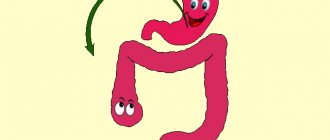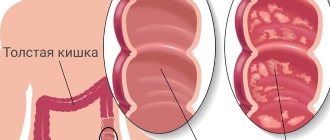Date of publication: 04/01/2016
until March 31
We are giving away 1000 rubles for all services for a visit in March More details All promotions
Vomiting is the expulsion of stomach contents through the mouth. This is how the body protects itself from getting into the stomach something that shouldn’t be there (toxins, poor-quality food, foreign bodies). The gag reflex is quite complex, involving various muscle groups. It is controlled by the vomiting center in the brain. Therefore, in reality, the causes of vomiting are quite varied, and not all of them are associated with problems of the gastrointestinal tract.
More about vomiting
Vomiting occurs more often in children than in adults, especially at an early age. This is due to the underdevelopment of the systems responsible for digesting food (they are formed over several years); In particular, young children lack mechanisms to prevent food from moving from the stomach back into the esophagus.
Nausea in children: what is it?
Among all the symptoms, nausea is a subjective and extremely unpleasant, painful sensation. It itself is not accompanied by pain, but is subjectively poorly tolerated, creating a feeling of fullness in the stomach with an irresistible desire to empty it. Although it is difficult to convey in words exactly the feeling of vomiting, even small children quickly and easily recognize this symptom and let their parents know about it. Against the background of many pathologies, nausea precedes vomiting, but can often occur in isolation, being a symptom of both digestive disorders and various serious problems of the body not related to the gastrointestinal tract.
Nausea is often accompanied by a sharp decrease in appetite, up to anorexia, as well as refusal of any type of food, even the most favorite dishes. Also, against the background of nausea, the child suddenly turns pale both in the face and in the body due to vascular spasm, his hands and feet become cold, severe anxiety and irritation develop, as well as lethargy and apathy. Against the background of nausea, specific urges and behavioral reactions appear externally, which allow parents to recognize the symptom.
Important
Nausea is always an alarming sign for a child; if a child suddenly becomes ill, he has complaints of nausea (even without vomiting), it is important to establish the true causes of this symptom due to the fact that the causes can be digestive disorders, infections and toxicosis, as well as and mental disorders, neurological, tumor and other processes. Sometimes nausea without vomiting occurs as an acute psychotic reaction of a child to the actions of parents, mainly related to violence (physical or moral).
There can be many reasons for the formation of nausea in infants and children at different ages, starting from infancy, but it is worth examining certain of them that occur most often and can bother the child the most.
Causes of nausea in children
If the intensity of nausea is insignificant and the child’s overall condition is normal, this is a functional disorder of the digestive system. The reason is nutritional errors:
- systematic overeating;
- products that do not correspond to the age category;
- low-quality infant formula;
- improper introduction of complementary foods;
- heavy food - fatty, fried, smoked, salted, pickled, excess seasonings and spices;
- violation of feeding regime;
- consumption of exotic dishes and products.
Functional disorders that cause nausea are associated with the immaturity of the child's body. This condition occurs as a result of a lack of pancreatic enzymes and insufficient flow of bile into the duodenum.
The second most common cause is food poisoning or acute intestinal infection. In these cases, nausea and vomiting in the child are the main symptoms. Their intensity and nature determine the degree of damage to the gastrointestinal tract. Pathology develops as a result of the ingestion of spoiled products contaminated with bacteria (staphylococci, streptococci, dysentery). Food poisoning is not always accompanied by an intestinal infection and differs from it in that the child does not have a high fever, excessive repeated vomiting or diarrhea, dehydration and severe intoxication of the body.
Other causes of nausea in a child:
- Nausea as a side effect when taking medications.
- Weak vestibular apparatus, which is normal for children. Nausea in children occurs when traveling by car or on public transport (motion sickness). It can also occur with a sudden change in body position if the child is weakened during a long illness.
- Long-term therapeutic diet.
- Brain injuries - bruise, concussion, compression.
- A common cause in children of preschool and primary school age is sunstroke or heatstroke.
- Internal diseases - gastritis, pancreatitis, cholecystitis, dyskinesia (obstruction) of the bile ducts, malignant tumors, ARVI.
- Entry of a foreign body into the stomach.
Poisoning, infection: mechanism of action
A state of acute poisoning or intoxication in childhood develops after a short period (from minutes to a couple of hours) after consuming certain foods or drinks. As a result of violation of storage periods or transportation conditions, temperatures or other factors, these products were spoiled and contaminated with pathogenic flora, parasites, and dangerous viruses. It is also possible that poisoning or toxic infection may occur if the technological process is disrupted - pre-processing, food preparation. Against the background of massive and severe poisoning, vomiting is typical, in milder cases - nausea with dyspeptic symptoms. Typically, nausea occurs in response to irritation by toxic metabolic products of the intestinal wall, which sends impulses to the nausea and vomiting center in the brain. There may also be direct irritation from toxins absorbed into the blood of this part of the child’s brain.
Manifestations of nausea develop abruptly, against the background of previous complete health, the first signs and mild nausea begin after 15-30 minutes or even 4-6 hours, depending on whether it is poisoning or the development of an intestinal infection . Initially, the attacks of nausea are mild and short-lived, but can gradually turn into a painful painful feeling, ultimately leading to vomiting. There may also be upset bowel movements (diarrhea), abdominal pain, malaise, pallor and headaches. Often, several family members suffer at once, who, along with the child, consumed dangerous foods and dishes, but the degree of severity in children is always brighter due to the immaturity of the body.
How can I help you?
Gastric lavage often helps with the elimination of dangerous toxins and food debris, taking sorbents in the form of Activated Carbon, Smecta, Polysorb, Polyphepam, etc., drinking plenty of fluids, a temporary change in diet with the intake of non-irritating food, or a short break in the diet to relieve digestion , nausea gradually disappears.
We recommend reading: Diet for poisoning in children: what to feed a child, sample menu
Types of vomiting
First, you should familiarize yourself with the types of vomiting and what danger each of them poses to the child’s body. Depending on the reasons, the color and other characteristics of the vomit may vary.
Vomiting with mucus
Diseases of the central nervous system can cause vomiting of mucus.
This kind of vomiting is common for infants, because often sputum from the bronchi and nasopharynx gets into their vomit.
And the gag reflex in this case can cause the usual oversaturation of the stomach.
Sometimes the cause of such vomiting is acute inflammation of the gastric mucosa.
Usually it can be caused by some irritating substances, for example, medical painkillers or antipyretic drugs.
Such vomiting often indicates an exacerbation of chronic gastritis, which can be caused by dietary errors. Also, the causes of mucous vomiting can be diseases of the central nervous system.
Often this symptom is a consequence of food poisoning.
Biliary vomiting
Biliary vomiting occurs when overeating.
A very common type of vomiting. The fact that vomiting is bilious can be recognized by the characteristic green color of the vomit.
Infection with intestinal infections: mild course
A common reason for the development of nausea in childhood is infection with viral, microbial, or parasitic intestinal infections. Frequent causative agents of such pathologies are rotavirus and adenovirus, an enterovirus group of pathogens, and among microbes these are staphylococcus, salmonella and E. coli . Infection with protozoa such as Giardia or Amoeba may also cause nausea. Basically, the source of infection is hidden among others - children or adults (both carriers and those suffering from these pathologies), but animals can also become sources of some infections.
The infection can be transmitted from sick children to healthy ones through unwashed hands when licking fingers, through shared toys contaminated with pathogens, through poor-quality food or water, including bathing, swimming in pools or reservoirs. Any surfaces and environments contaminated with pathogens can become dangerous.
If this is a relatively mild infection, there may only be nausea and minor intestinal upset, bloating and diarrhea, as well as lethargy and weakness, and irritability of the child . As the pathology progresses or is severe, nausea and vomiting are often combined, but if the intestines are predominantly affected, vomiting may not occur, and nausea itself manifests itself as a reaction to microbial or viral toxins, dehydration and temperature. The combination of certain symptoms and the severity of the condition depends on the specific type of pathogen, the age of the child and the severity of the lesions.
How can I help you?
It is important not to self-medicate, call a doctor and determine the cause of the infection, select a comprehensive treatment, including antibiotics if it is a microbial process, as well as a drinking regime and a therapeutic diet to eliminate nausea.
First aid for a child with symptoms of nausea
Diagnosis, first aid tactics and elimination of symptoms depend on the types of nausea, which are classified according to their origin:
- Reflex – after eating.
- Toxic – as a result of exposure to poisons, toxic substances, pathogenic microorganisms.
- Vestibular – disruption of the vestibular apparatus (responsible for coordination of movements).
- Brain – for somatic and infectious diseases of the brain.
- Metabolic – metabolic disorder, vitamin deficiency.
General principles of first aid
If the child is over 2 years old and feels relatively normal, you can cope with nausea on your own. The baby needs to have a pediatrician come to his home for an examination and recommendations on further actions. If the child’s condition is serious, accompanied by additional symptoms (the child begins to vomit) and rapidly worsens, it is necessary to call an ambulance, regardless of the age of the victim.
Put the baby to bed and free him from tight clothes. Wipe the skin of the face, neck, chest, hands with a towel dipped in warm or cool water. If the child is worried about chills, cover him with a warm blanket or blanket. During nausea, there is no need to force the child to eat something. The products will irritate the mucous membranes and increase discomfort.
If nausea appears after eating, you can try to induce artificial vomiting. This will significantly improve the child's condition. To do this, let the child drink 1-2 glasses of water for a short time, sit him on a chair, then press on the root of the tongue with two or one finger (depending on the child’s age) and provoke a gag reflex. This procedure should not be performed on infants, as there is a high risk of vomit entering the respiratory tract.
It is strictly forbidden to induce vomiting if the nausea is caused by a head injury. This will not bring relief and will only worsen the baby’s condition.
ARVI, influenza, childhood infections, inflammatory processes
At the age of 4-5 years, many severe childhood infections, colds and flu due to symptoms of intoxication can cause nausea against the background of fever, malaise and headache, and the general unsatisfactory condition of the baby. The higher the degree of fever, the more likely nausea is, and the younger the baby, too. The mechanisms for the development of nausea during colds and infections are simple; they are associated with high sensitivity and stimulation of the vomiting center in a special part (stem) of the brain, especially against the background of irritation by toxins circulating in the plasma during infectious diseases. It has a similar effect on the vomiting center and the course of infectious and inflammatory processes - otitis media, pneumonia, pyelonephritis; nausea is also typical for influenza.
Important
Nausea in such pathologies is typical for a very severe and often complicated course of the pathology, with normal stool becoming its main features. Abdominal pain is also possible, and it can be the result of an infectious process.
The child started vomiting - what to do?
If vomiting occurs, the child should be given water.
First of all, you shouldn’t panic, but you should figure out when you should turn to specialists, and whether you should do it at all.
It is best, of course, to play it safe and call a doctor, especially if the vomiting does not stop for several minutes or repeats several times over the course of an hour.
And if there is blood in the vomit, you should call an ambulance immediately. Well, while the pediatrician is on the way, you should provide first aid to the baby:
- First, you should create comfortable conditions for the child, place him comfortably on a high pillow and always on his side, so that in the event of an attack of vomiting, the vomit cannot enter the respiratory tract. A basin should be nearby just in case. In the case of infants, it is better to hold them in your arms in an upright position.
- During such periods, children should be given water to drink in order to protect their body from dehydration. Water should be drunk in small sips. Babies can be soldered from a pipette or a teaspoon. This procedure is resumed every 5 minutes. It is best to use a solution of rehydron or similar drugs as a liquid. They will help restore water loss, and at the same time enrich the child’s body with the microelements it needs. You can also use alkaline mineral water for these purposes.
- If there is blood in the child's vomit, while waiting for an ambulance, you should put an ice pack on the child's stomach, or even better, ask him to swallow a small piece of ice. This will cause the blood vessels to narrow from the cold and the bleeding will stop. If there is bleeding, the child should not be given water.
- After each vomiting attack, it is necessary to wash the child’s face and allow him to rinse his mouth, because often gastric juice can cause irritation of the oral cavity.
- Before the doctor arrives, it is not recommended to give children any medications; they will be prescribed by the doctor through a personal medical examination.
- Also, children should not be given any food.
The pediatrician or emergency specialist who arrives on call will perform a thorough examination, and based on the words of the parents, visual examination of the vomit and other symptoms, he will decide to hospitalize the patient for a more thorough diagnosis, or to carry out treatment at home. Typically, after diagnosis, doctors prescribe the following medications:
- Antiemetic drugs that are safest for the child’s body, for example, Cerucal or its analogue - Metoclopramide or Motilium (Motilak), an analogue of which is Domperidone.
- If vomiting is caused by pathogenic microbes, antimicrobial or antiviral drugs may be prescribed.
- The use of sorbents, for example, Polysorb MP, Enterosgel, and activated carbon, may also be indicated. Often, a doctor may prescribe Smecta. Smecta is a local drug; due to its enveloping properties, it prevents microbes and toxins from being absorbed into the blood, and slows down gastric peristalsis, thereby reducing the urge to vomit.
For increased abdominal pain, the doctor may prescribe antispasmodics or antisecretory drugs.
Pathologies of the nervous system, trauma, brain tumors
Damages to the central organs regulating all vital functions - the brain or spinal cord in children, as well as problems with the response of the peripheral nervous system can cause nausea . In this case it has a neurogenic (central) character. In children and adolescents, nausea also predicts or accompanies migraines.
note
Often painful and almost constant nausea accompanies serious and dangerous pathologies, injuries or lesions of the central parts - meningitis or encephalitis, and it also often forms as a reaction to a concussion or contusion of the brain.
This kind of nausea can occur either in isolation or accompanied by rare bouts of vomiting that does not bring relief; there may be severe headaches and dizziness, double vision and disturbances of consciousness.
Neurological pathologies, along with nausea, are often accompanied by a general disorder - excitability or lethargy of children, their sharp tearfulness and whims, refusal to eat, regurgitation, decreased motor activity, prolonged sleep or insomnia.
At an early age, nausea is accompanied by heart-rending screams and hysterics, bulging fontanel, hysterics, neurological symptoms and fear of light. Fever and convulsions may occur, often with complete loss of consciousness, which is life-threatening and requires immediate calling an ambulance and hospitalization for examination in a hospital.
Causes of vomiting in a child
The cause of vomiting in children can be:
- teething;
- reaction to the introduction of complementary foods;
- indigestion or overfeeding;
- mental reaction (in children over 3 years old);
- the body's reaction to changes in climate zone;
- gastroesophageal reflux (involuntary reflux of gastric contents into the esophagus);
- acute infections;
- diseases of the pancreas, gall bladder and liver;
- congenital gastrointestinal defects;
- diseases of the central nervous system;
- ingestion of a foreign body.
Surgical pathology, acute abdomen
Often, pathologies of the digestive system and abdominal pain can begin with nausea and malaise. The stronger the pain, the more often and more strongly it provokes nausea. Often, manifestations of appendicitis and cholecystitis, the development of any types of intestinal obstruction and some other pathologies begin with nausea and the appearance of pain impulses in the abdomen . This is due to powerful pain impulses into the brain area, leading to irritation of the vomiting center and provoking nausea. This is its central mechanism. Additional stimuli for the development of nausea are also fever during acute surgical pathology, intoxication with metabolic products and tissue death, and ischemia of intestinal areas . Typical pain is in the navel area, under the ribs or throughout the abdomen, sharp and sharp, nausea, screams and crying of the child, and his excitement. Additional symptoms of danger are, against the background of nausea, retention of stool and passing of gas against the background of a sharply swollen abdomen. But stool liquefaction, one-time vomiting, headaches and toxicosis are also possible.
How can I help you?
You cannot give your child any medications (anti-vomiting and nausea, painkillers, antispasmodics), you must immediately call an ambulance and, if you suspect surgical pathologies, be hospitalized in a hospital for surgery.
Causes of nausea and vomiting
Vomiting does not always indicate a disease of the digestive tract, but most often the cause of vomiting and nausea is found in the digestive system.
- Gastroenteritis, or inflammation of the stomach and intestines, due to ingestion of poor-quality food, contaminated water, leading to the development of food poisoning.
- Long-term (chronic) diseases of the stomach (chronic gastritis, gastric ulcer, gastroparesis - complete lack of mobility and contractions of the stomach), stomach spasm (persistent tension of the stomach muscles, with the impossibility of passing food further), duodenal ulcer, duodenitis.
- Diseases of the gallbladder and liver, cholelithiasis, dyskinesia of the gallbladder, cholecystitis, blockage of the bile ducts, hepatitis.
- Emergency conditions: acute appendicitis, pancreatitis, cholecystitis, intestinal obstruction, perforation of a gastric or duodenal ulcer, gastric bleeding, etc.
- Anomalies in the development of the digestive system: diverticulum (blind appendage) of the esophagus, intestines usually lead to periodic nausea and vomiting.
- Stenosis (narrowing of the lumen) of the esophagus or pylorus.
- Tumors of the stomach and intestines.
Sudden nausea and vomiting, accompanied by rumbling in the stomach, diarrhea, mild fever, and weakness are most often a sign of food poisoning
. If food poisoning is suspected, the stomach should be rinsed with plenty of liquid. You can also drink activated carbon.
Nausea and vomiting accompanied by severe diarrhea (possibly mixed with blood), a significant increase in temperature, and severe weakness may be a sign of an intestinal infection. Severe nausea and vomiting, accompanied by discoloration of stool, dark urine and jaundice, are a clear sign of viral hepatitis. If you suspect hepatitis or acute intestinal infection, you should urgently show the patient to a doctor.
Nausea and vomiting that occur periodically (often) accompanied by symptoms such as abdominal pain, stomach pain, sour belching, bitterness in the mouth, stool discoloration, chronic diarrhea, constipation, are usually a symptom of gastritis, peptic ulcer of the stomach and duodenum, cholecystitis, chronic hepatitis, chronic pancreatitis. In these cases, treatment of nausea and vomiting
possible only after eliminating the underlying disease.
Since the initiation and process of vomiting itself is controlled by the “vomiting center” of the brain, some diseases of the nervous system can cause vomiting and nausea. Increased intracranial pressure is characterized by a persistent increase in cerebrospinal fluid pressure and compression of the brain. A slow increase in intracranial pressure is observed, for example, with brain tumors. In such cases, nausea and vomiting occur either in the morning, or mild nausea is observed throughout the day. Along with nausea, the patient may complain of headache, balance disorder, blurred vision, disturbances in gait or sensitivity, or weakness in any part of the body.
A sharp increase in intracranial pressure (cerebral edema, traumatic brain injury, concussion, bruise) is accompanied by severe vomiting and impaired consciousness.
Attention!
Persistent headaches accompanied by nausea or periodic “unreasonable” vomiting may be a sign of brain tumors or other diseases characterized by a slow increase in intracranial pressure! If you notice this symptom, you should immediately consult a doctor.
Infectious diseases of the nervous system (meningitis, borelliosis), damage to the nervous system due to syphilis or AIDS are also accompanied by vomiting. Of the conditions described, meningitis is most often observed. Nausea and vomiting may be among the first symptoms of meningitis. Attention!
In addition to nausea and vomiting, meningitis causes high fever, severe headache, and severe tension in the neck muscles. If these signs are detected, you should immediately call a doctor! Lesions of the vestibular apparatus (vertigo, motion sickness, motion sickness) are often accompanied by nausea and vomiting in combination with severe dizziness and loss of balance. With benign vertigo, nausea and dizziness occur suddenly at the moment when the patient abruptly changes the position of the body and head (for example, turning on the other side in bed). With seasickness or motion sickness, nausea and vomiting occur during travel by sea or land. If such symptoms are detected, you should contact a neurologist or otoneurologist!
Migraine is a special type of headache that occurs in 15-20% of the population. With migraine, nausea and vomiting occur against the background of a severe (sometimes throbbing) headache. In addition to nausea and vomiting, during a migraine attack there is photophobia (the patient cannot tolerate bright light) and noise intolerance. Migraine attacks recur periodically and can be triggered by foods such as wine, chocolate, cheese, and strong odors. If you suspect a migraine, you should consult a neurologist!
Foreign body of the esophagus, stomach, intestine
Often, nausea can occur due to pathological impulses from the walls of the esophagus or stomach, less often from the intestines, when foreign bodies enter them. They can be fruit seeds, small toys, objects that, due to their sharp edges and dense structure, irritate the delicate mucous membranes and injure them. You can expect similar nausea that occurs suddenly against the background of preliminary full health in children of the first 2-3 years, who could be left unattended while eating or playing with small objects. Nausea often develops some time (not long) after a foreign object enters the digestive tract.
What to do?
It is necessary to immediately show the child to a surgeon, perform radiography or fibrogastroduodenoscopy with simultaneous detection and removal of the object. Attempting to induce vomiting, taking laxatives, or otherwise attempting to independently remove foreign objects is prohibited.
Stomach pathologies, hunger, gastrointestinal tract
Nausea often occurs in children in the morning, immediately after waking up, and it is associated with severe hunger , when gastric juice is actively produced or due to excessive secretion of hydrochloric acid by the walls of the organ. As a result of irritation by excess acid in the gastric walls, pathological impulses arise in the subcortical formations of the brain, and the vomiting center is irritated. Then nausea occurs, there may even be attacks of vomiting with acidic stomach contents or an admixture of bile.
Nausea may occur in the morning and with biliary dyskinesia, especially against the background of dietary errors, consumption of fatty, choleretic foods, large meals at night, and consumption of concentrated juices.
What to do?
It is important to conduct a full examination of the child, change his diet and drinking regime, make dinners lighter, and avoid snacking at night and in the late evening before bed. You need to stop drinking juices or dilute them with water in a ratio of 1:3.
What to do if your child is vomiting
A single attack of vomiting in a child, as a rule, does not pose a danger. If a child has eaten something wrong, or if a rotavirus infection (the so-called “intestinal flu”) occurs, the body thus frees the stomach, and the child feels better.
If bouts of vomiting recur, the cause may be more serious. Also, with repeated vomiting, the child’s body becomes dehydrated, and this is dangerous. Therefore, if you vomit, you should definitely call a doctor.
If the child complains that he is vomiting, sit him upright so that vomit does not enter the respiratory tract. Do not leave your child unattended. Calm him down (many children begin to panic when they vomit). After an attack of vomiting, the child’s mouth should be washed and clothes should be cleaned. Give the child something to drink. Do not give any medications yourself until your doctor makes a diagnosis.
Make an appointment Do not self-medicate. Contact our specialists who will correctly diagnose and prescribe treatment.
Morning sickness, malaise
The appearance of nausea in the morning, in addition to problems with digestion, can be a symptom of intracranial hypertension , so it is necessary to visit a neurologist and conduct a full examination. You may feel sick in the morning due to stress, anxiety before an important event - this is the so-called “bear disease”, hyperexcitability of the parasympathetic part of the nervous system due to the powerful release of stress hormones. It can manifest itself not only with nausea, but also with diarrhea, constipation, bloating and pain, dizziness and panic, and a feeling of lack of air. In this situation, talking with the baby, calming down and taking light sedatives (drops, herbal teas, syrups, decoctions) will help.
Nausea in transport, motion sickness
Nausea often occurs as a result of overexcitation of the vestibular apparatus and the development of motion sickness, “sea sickness.” This is possible from an early age, 2-4 years, until adolescence, until all parts of the vestibular apparatus are completely formed. The more trained children are, the less likely they are to develop motion sickness. More often, nausea and dizziness occur in children who are excitable and capricious, prone to hysterics and impressionable. It is important to avoid long rides in stuffy transport, on a ship or in a car, and to accustom children to travel from childhood.
note
It is also important to exclude processes of chronic inflammation in the middle ear, which can lead to the formation of motion sickness due to irritation of receptors in the ear and transmission of impulses to the brain and the vomiting center.
How can I help you?
If you need to travel due to motion sickness, special medications, drinking water in small sips, sucking sour candies, sleep or auto-training in fresh air will help.
We recommend reading: Motion sickness (sea sickness): causes, treatment, prevention
Main causes of nausea
Diseases of the gastrointestinal tract (GIT)
- gastritis and other inflammatory diseases of the stomach and intestines, including enterovirus infection, appendicitis,
- inflammation of the pancreas - pancreatitis,
- gallbladder diseases, including calculous cholecystitis,
- gastrointestinal tumors, intestinal obstruction.
Pathology of the central nervous system
- head injuries
- hypertensive crisis
- cerebrovascular accident
- inflammation of the meninges (encephalitis, meningitis)
- tumors of the brain or its membranes
Nausea of central origin includes nausea that occurs during motion sickness, that is, when the functioning of the vestibular apparatus is disrupted.
Intoxication
- acute or chronic poisoning
- insufficiency of liver and kidney function due to hepatitis, cirrhosis, nephritis,
- hypothyroidism, thyrotoxicosis,
- toxicosis of pregnancy,
- malignant tumors,
- drug therapy (nausea can be caused by salicylates, antibiotics, cytostatics and many other drugs).
Other
- binge eating,
- physical activity on a full stomach,
- severe stress.
Nausea as neurosis, hysteria
Children often begin to feel sick after violent and noisy games, sharp and powerful, prolonged overexcitation of the nervous system, both positive and negative. Hysterics, crying and screaming, choking with tears often lead to nausea and even one-time vomiting, but after calming down, all symptoms disappear. This is due to the immaturity of the nervous system and its rapid overexcitation due to excessive stimuli and the release of excess stress hormones, hyperventilation (frequent and intermittent breathing during hysterics).
How can I help you?
It is important not to overexcite the child, avoid hysterics and prolonged crying.
Why is nausea dangerous?
The appearance of nausea (except for that which occurs against the background of hysterics and violent games, screams) is a reason for parents to worry and see a doctor. This is a sign of problems and various pathologies of the body, for which treatment is often necessary. It is subjectively more difficult for children to tolerate nausea, even than vomiting, because it does not bring relief and creates even more unpleasant symptoms. Although nausea is not a disease, but only one of the symptoms, it is important not to ignore such complaints. But while older children may complain that they feel sick, it is more difficult to recognize this in babies - signs of nausea include refusal to eat and drink, whims and periods of paleness, with perspiration on the forehead and contraction of the muscles of the pharynx and abdominals. If you sweat profusely, your legs and arms will be icy and pale.
Due to nausea, it is prohibited to take medications against nausea and vomiting, make dietary adjustments, and treat the baby yourself. It is important to see a doctor and find out exactly all the reasons .
Alena Paretskaya, pediatrician, medical columnist
26,532 total views, 1 views today
( 57 votes, average: 4.89 out of 5)
Stomach hurts after eating: what to do?
Liver cirrhosis: symptoms and treatment
Related Posts
Diagnostic stages
1. Consultation with a therapist or gastroenterologist.
To find out the causes of nausea, it is important to study the sensations accompanying it, the conditions for its occurrence and other details. A consultation with a therapist or gastroenterologist with a detailed collection of complaints and anamnesis will help determine the direction of the diagnostic search, outline the necessary studies, tests and consultations with other specialists.
2. Examination.
To identify diseases of the gastrointestinal tract that can cause severe nausea, the following diagnostic methods are used at the Yauza Clinical Hospital:
- a full range of laboratory tests of blood and stool,
- endoscopy at partner clinics (gastroscopy, colonoscopy),
- ultrasound diagnostics (internal organs, blood vessels),
- their combination (endo-ultrasound)
- X-ray examinations, MRI and CT,
- according to indications - a cancer search program - MRI of the whole body (MR - diffusion), genetic testing for predisposition to oncological processes and blood testing for tumor markers, a complex of neurological diagnostics, etc.
Treatment
It is recommended to adjust your diet and diet, and, if possible, adjust drug therapy (if medications are the cause of constant nausea). But the main condition for the successful treatment of nausea is an accurate diagnosis of its cause and its elimination. All conditions have been created for this in our hospital.
An individual, comprehensive approach to the treatment of each patient almost always helps to get rid of an unpleasant symptom. For the period of treatment or in case of an unavoidable cause, for example, when using vital medications that provoke nausea, antiemetic drugs are prescribed, which significantly alleviate the condition.
If you experience nausea after eating or not related to eating, contact gastroenterologists or therapists at the Yauza Clinical Hospital. Our specialists will help you identify and eliminate the cause of the unpleasant symptom and return you to good health.
You can see prices for services











